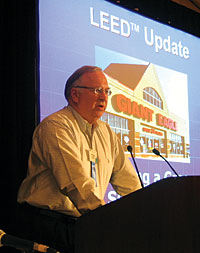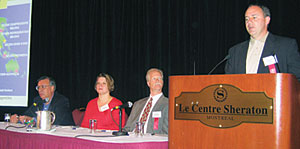
They listened to more than a dozen talks on the latest trends in equipment, installation, and servicing as well as news concerning refrigerants and regulations. Buyers and vendors also had time to talk in both formal and informal sessions.
Regulation Issues
Deborah White, vice president and associate council for FMI, talked about continuing efforts of the trade association to work with the U.S. Environmental Protection Agency (EPA). In general both FMI and EPA promote the use of non-ozone depleting HFC refrigerants. In fact, the EPA continues to have no leak rate or reporting requirements concerning HFC refrigerants as it does for CFCs and HCFCs.Initially, White said, there was an effort to garner some sort of industry-wide agreement on various regulatory issues. But recently she said the EPA has begun talks with at least two companies in the supermarket sector concerning such matters.
She also told audience members that owners and operators of equipment now have two ways to calculate leak rates - one is an annualized method and another deals with rolling average. This gives more options in the reporting process, she noted.

Refrigerant Focus
Warren Beeton, vice president, engineering, Copeland, Sidney, Ohio, took a look at the range of issues regarding refrigerants. He noted that while much of the developed world has endorsed the Kyoto Protocol regarding reducing emissions, the United States has not. But he noted challenges signers face. For example, Canada promised to reduce such emissions by 6 percent over 1990 levels. But increased industrialization and use of automobiles have in reality put such percentages in double digits now, he said.Even without federal government approval in the United States, Beeton warned attendees to pay attention to potential state regulations. Already, he said, California is moving on emission regulations regarding automobiles, and other states may follow suit.
From a global perspective, there are differences. He said Europe is trying to deal with global warming through rules and regulations (including a future ban on HFC-134a in automobiles) while the focus in the United States is to use "innovation and energy efficient" equipment to respond to global warming potential.
In terms of specific refrigerants for refrigeration, Beeton said HFCs 404A and 507 are top picks. He said the refrigerant HFC-422A that was created for use with mineral oil as well as POE, is viable in some applications as long as an oil separator is used.
He told audience members to remain proactive in efforts to control emissions and use the most energy-efficient equipment. Failure to do so could put the industry under greater regulatory control.

Going Green
There is a lot of talk about supermarkets going green, in terms of politically correct environmental considerations. But, how do you measure greenness?For Cliff Timko, energy manager, conservation department, Giant Eagle Inc., Pittsburgh, it meant using the Leadership in Energy and Environmental Design (LEED) rating system developed by the United States Green Building Council for one of its stores scheduled to come on-line.
The system offers a point system with Platinum, Gold, Silver, and Certified levels. Super Giant opted to aim for the Certified level because there was a belief that present practices as well as some tweaking might gain that recognition. Cost considerations also entered into the equation.
"The ideal was not to make any major changes to floor plans nor do anything exotic," Timko said.
LEED wants no CFCs used, an easy matter for Giant Food since "we haven't had those in a new store in 15 years," Timko said.
The specific mechanicals for this project were an HVAC system that had been designed for HCFC-22, but was running on the HFC R-417A. Refrigeration equipment ran on HFC-404A. There are brazed plate heat exchangers and stepper motor technology.
One innovation involved the purchase of some power from a wind energy farm. At the same time, at least one aspect was decidedly and intentionally nongreen. That was adding a 60-kW diesel generator that could run all HVACR equipment in case of a power failure.
The innovations put the store solidly in the certification range, quite close to the silver level. The certification label was heavily promoted, resulting in trade magazine stories, news articles, a local news station report, and an especially favorable rating from shoppers who said they gave high priority to the green concept. Timko said many aspects of the certification project would be incorporated in other stores to come on-line.

Compressor Choices
A quartet of persons from the manufacturing sector talked about the latest innovations in compressors for both air conditioning and refrigeration.Richard Kobor, president, Bitzer North America, Oakland, Ga., talked about semi-hermetic recip technology, particularly his company's Octagon one-piece housing unit designed for high stability and useable with such refrigerants as R-410A and CO2.
Dan Mason, director, North American sales, for Danfoss Turbocor, Landsdale, Pa., talked about the Turbocor compressor that he said was a variable-speed, direct drive, oil-free, hermetic centrifugal designed with less weight and size than compressors with similar capacity.
Deb Monnin, director of refrigeration scroll engineering for Copeland, highlighted upgrades to the company's semi-hermetic Discus compressors that included an extended envelope for low-condensing operations. Scrolls were noted as ranging from 6 to 15 hp with vapor injection replacing liquid injection in low-temperature applications.
Paul Tollar, application engineer for Carlyle, Syracuse, N.Y., noted its range of compressors, the updating of software to optimize compressor selection, and continued research into CO2 as a refrigerant for use in North America, the latter an ongoing project that has yet to draw conclusions.

Secondary Loop
Secondary-loop technology for supermarkets drew considerable attention at the conference with a number of proponents noting the approach uses less refrigerant and has fewer leaks than a direct-expansion system.Dave Godwin, environmental engineer for the EPA, emphasized that low-leak contention. He noted considerable research concerning the technology and cited studies in California and Sweden.
"Zero or near-zero refrigerant loss is achievable," he said. While direct expansion still dominates in the United States, he said such technology is being phased out in Europe (where systems are smaller) in favor of secondary loop.
He said the EPA would continue to work with FMI with the possibility of a position statement regarding secondary loop.
"If FMI and EPA work toward an enforcement agreement, discretion for secondary loop is an option," he said.
Three retailers then offered views on the technology. Mark Rorhback, director of store development for Clemens Family Market, Kulpsville, Pa., reviewed some work the chain has done with second loop in medium-temperature applications. He said consideration should be given to the fact that installation costs, while still higher than direct expansion, "is a one time upfront charge, not an ongoing expense." And he said the difference could be lowered over time with more training in such installation work.
Tony Papagna, director of refrigeration for Sav-A-Lot Ltd., Earth City, Mo., said that the simplicity of a secondary-loop system "can open the door for mechanical contractors to start servicing stores."
Offering a Canadian perspective was Mark Schembi, senior director, procurement and engineering for Loblaw Companies Ltd., Weston, Ontario. He noted the push in Canada toward secondary loop is because the country is a signer of the Kyoto Protocol and as such has to reduce emissions. Reduction of HFC refrigerants is believed to be one way to move in that direction.
While U.S. stores that try secondary loop usually do so only in medium-temperature applications, Loblaw in Canada is also trying it in low-temperature applications. In low temp, Schembi said, potassium formate is used along with R-404A, whereas medium temp uses propylene glycol.
"There is still work to be done" in low temp, he said, "but we are making the best of it."
Technician Search
How do you find good technicians? "You often can't find them. You have to grow them," said Jerry Meyer, manager, Hussmann Learning Solutions, Bridgeton, Mo. He spoke of his company's efforts to provide levels of training for service installers and technicians, of which the company has about 1,600.While service personnel being hired by Hussmann are expected to have tech school training, the company considers itself responsible for additional and ongoing training. Weeklong courses are conducted at a facility in Minneapolis on refrigeration fundamentals, refrigeration system servicing, HVAC servicing, and installation techniques. There is no cost to the individual.
Testing is done at various levels, leading to comparable levels of certification. "The idea is to identify those that need training, recognize and reward them for what they know, motivate them to study, and provide a career path," Meyer said. All this helps in recruitment, he said. "We can tell a prospective technician that we have a career path for him."
He told those in the audience with hiring responsibilities to "know what you are looking for in terms of key technician skills, outline the skills needed, and ask yourself, ‘Why are we the preferred employer?'"
He also noted that a retention process begins with the interview part of the recruitment process. "Give them special attention. Don't rush things," he said. "We tell our branch managers there is a direct correlation between employee satisfaction and customer satisfaction."
Retention efforts continue while the tech is working for the company. "When you think you don't have 10 minutes a day to talk to your tech, imagine how much time it would take to replace him."
Looking At Leaks
With the EPA requiring leak rates of not more than 35 percent a year and the supermarket industry in general in the 20 to 30 percent range (lower in some cases), advocates of tight systems still aren't satisfied.A recurring message at the conference was that zero or near-zero leak rates are possible, and in a cost-effective manner.
According to presenter Ed Estberg, senior director of facilities for Raley's, West Sacramento, Calif., "There is no reason we can't stop leaking refrigeration systems with the technology we have today."
He called on manufacturers to design components with more attention given to the leak issue, even if the product winds up costing a bit more. "Equipment buyers are going to have to be willing to pay more," Estberg said, adding that such upfront costs would be recovered with lower refrigerant costs.
Ray Hoglund, president and chief executive officer of Hill Phoenix, looked at the issue from his capacity as deputy chairman of the Commercial Refrigeration Manufacturers Division of the Air-Conditioning and Refrigeration Institute (ARI).
He noted that on average, leak testing and related service costs a store about $7,000 a year. With 30,000 supermarkets in North America, that means a cost of $210 million a year that could be utilized elsewhere. He asked supermarket officials to be willing to submit their leak rate information in confidence to CRMD (especially info that identifies where in the system leaks occur), so that such information could be used as part of ARI research and development. "The goal is to eliminate all refrigeration leaks in retail operations. It is possible," Hoglund said.
Publication date: 11/28/2005


